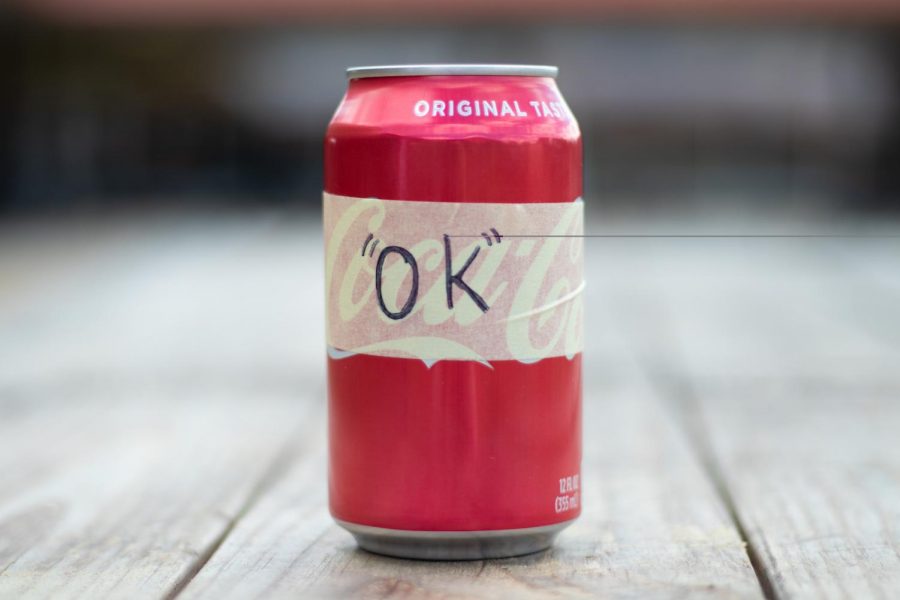Redefining OK
The impact of unconventional advertising on teenagers
Photo by Sophie Spakes
Photo Illustration
October 7, 2019
The Coca Cola Company looms large as one of the world’s most successful businesses, recognizable by its ruby colored cans and cursive fonts alone. However, even the beverage industry’s apex predator must search for a new schtick on occasion.
Many corporations today grow complacent as their popularity increases. However, in 1993, the Coca Cola Company refused to take the predictable path to catch the attention of Generation X. Teens and young adults of the era were bored with the overly optimistic ads of the 80s.
The Coca Cola Company mirrored this attitude with OK Soda, a carbonated beverage that proudly marketed itself as “unremarkable.” During their attempt at this new branding, they ignored the cheerful claims from their prior advertisements. The company decided the slogan “Have a Coke and a smile,” was a cliche. Now, the phrases in its commercials, “Things are going to be OK” and “OKness,” were all the rage, or at least that was Coke’s intention.
Despite extensive advertising in the form of odd artwork and commercials, Coca Cola pulled the plug on the product after unsatisfactory results in test markets, just two years following its conception, according to Buzzfeed. This marketing scheme is now considered a failure compared to the company’s history of success.
However, the real problem with the product may have been time. With each generation comes new opinions, and Gen Z, the generation of current high schoolers, is no different.
“It’s a cool phrase, “OKness.” It made me want to try it,” sophomore Angie Parrott said. “The way [Coca Cola is] putting it makes it sound better than just the word okay.”
OK Soda takes a refreshing spin on the concept of being average, even bragging that a sip from their substance brings the drinker to a “very OK” state of being, which the product endorses in its commercials.
The word “OK” also sets low expectations for consumers. If a product undersells itself, buyers are unlikely to be disappointed in it.
“It’s very average and everyone likes that in Gen Z,” junior Blaine Johnson said. “They know it’s not going to be great.”
Despite these seemingly clever marketing tactics, some students were not impressed with the product, remarking that it is too concerned with their uniqueness as shown in the random structure of its commercials.
“[The idea would have worked better] if they would have went about it a different way,” sophomore Alex Hines said. “[Like if] they tried to approach things differently and use better visuals other than just random soda cans appearing out of thin air.”
Hines also critiques it artistically, commenting on its can designs, ranging from hyper realistic greyscale drawings to red disproportionate faces. She saw the latter as a poorly executed imitation of one of history’s most renowned artists.
“Picasso’s art style was very not set in a form. The eyes would be like one’s up on the forehead and the other’s down. Everything’s scattered about,” Hines said. “[The cans are] trying to be Picasso, but they can’t because it’s not.”
Although Hine’s critical perspective reflects the opinion of its original test subjects, others before her responded more positively to the product than those of the 20th century, indicating a change in society’s morale.
Freshman Cortez Gracy blames this on a rocky political atmosphere seeping into the attitudes of teenagers.
“We have immigration going on.” Gracy said, “People are shooting up areas due to the fact that they don’t feel like they’re treated right.”
Parrott, however, attributes society’s negative nature to the rise of social media platforms such as Twitter and its cynicism.
“It’s become a society rule to see the worst in some things and say whatever you want about it,” Parrott said. “You don’t always have to look at the bright side.”
OK Soda’s defiant rejection of this bright side, regardless of its prosperity as a long term marketing technique, is undeniably attention-grabbing. Their reverse psychology approach leaves people with questions only answered upon purchase of this aggressively average beverage.
While it’s not the most economically effective technique for running a business, OK Soda serves as a reminder to take risks. Never encumber yourself in the boundaries society sets as positive and negative. Explore the gray areas of emotions rarely acknowledged instead of the extremes, because one failure in corporate America’s olden days may resonate with new generations to come. If nothing else, OK Soda reminds us of one of life’s most basic principles.
“Sometimes, it’s OK to be OK,” Parrott said.
















